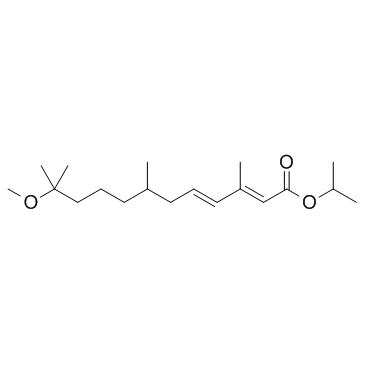Methoprene

Methoprene structure
|
Common Name | Methoprene | ||
|---|---|---|---|---|
| CAS Number | 40596-69-8 | Molecular Weight | 310.471 | |
| Density | 0.9±0.1 g/cm3 | Boiling Point | 385.7±25.0 °C at 760 mmHg | |
| Molecular Formula | C19H34O3 | Melting Point | 164ºC | |
| MSDS | Chinese USA | Flash Point | 162.4±17.8 °C | |
| Symbol |


GHS07, GHS09 |
Signal Word | Warning | |
|
Methoprene-tolerant (Met) knockdown in the adult female cockroach, Diploptera punctata completely inhibits ovarian development.
PLoS ONE 9(9) , e106737, (2014) Independent of the design of the life cycle of any insect, their growth and reproduction are highly choreographed through the action of two versatile hormones: ecdysteroids and juvenile hormones (JH). However, the means by which JH can target tissues and exer... |
|
|
Methyl farnesoate plays a dual role in regulating Drosophila metamorphosis.
PLoS Genet. 11(3) , e1005038, (2015) Corpus allatum (CA) ablation results in juvenile hormone (JH) deficiency and pupal lethality in Drosophila. The fly CA produces and releases three sesquiterpenoid hormones: JH III bisepoxide (JHB3), JH III, and methyl farnesoate (MF). In the whole body extrac... |
|
|
Ligand-binding properties of a juvenile hormone receptor, Methoprene-tolerant.
Proc. Natl. Acad. Sci. U. S. A. 108(52) , 21128-33, (2011) Juvenile hormone (JH) is a sesquiterpenoid of vital importance for insect development, yet the molecular basis of JH signaling remains obscure, mainly because a bona fide JH receptor has not been identified. Mounting evidence points to the basic helix-loop-he... |
|
|
Juvenile hormone (JH) esterase of the mosquito Culex quinquefasciatus is not a target of the JH analog insecticide methoprene.
PLoS ONE 6(12) , e28392, (2011) Juvenile hormones (JHs) are essential sesquiterpenes that control insect development and reproduction. JH analog (JHA) insecticides such as methoprene are compounds that mimic the structure and/or biological activity of JH. In this study we obtained a full-le... |
|
|
Seasonal variation in the titers and biosynthesis of the primer pheromone ethyl oleate in honey bees.
J. Insect Physiol. 58(8) , 1112-21, (2012) Honey bees allocate tasks along reproductive and non-reproductive lines: the queen mates and lays eggs, whereas the workers nurse the brood and forage for food. Among workers, tasks are distributed according to age: young workers nurse and old workers fly out... |
|
|
Efficacy of a novel topical combination of fipronil, (S)-methoprene, eprinomectin, and praziquantel, against the ticks, Ixodes ricinus and Ixodes scapularis, on cats.
Vet. Parasitol. 202(1-2) , 59-63, (2014) Five controlled, blinded and randomized studies were conducted to examine the efficacy of a single topical application of a combination of fipronil, (S)-methoprene, eprinomectin, and praziquantel (BROADLINE(®), Merial) against induced infestations with Ixodes... |
|
|
Efficacy of a single dose of a novel topical combination product containing eprinomectin to prevent heartworm infection in cats
Vet. Parasitol. 202(1-2) , 49-53, (2014) Cats may be infected by heartworm, Dirofilaria immitis, through mosquito bites. They can develop severe heartworm disease when infective D. immitis larvae migrate and develop into adults in the pulmonary vasculature or other tissues. As there is no curative t... |
|
|
Efficacy of a novel topical combination of fipronil, (S)-methoprene, eprinomectin and praziquantel against experimental infections ofToxascaris leoninain cats
Vet. Parasitol. 202(1-2) , 40-4, (2014) The efficacy of a novel topical fipronil, (S)-methoprene, eprinomectin and praziquantel combination product (BROADLINE®, Merial) was evaluated against adult Toxascaris leonina ascarids in experimentally infected cats in two controlled studies under an identic... |
|
|
Efficacy in cats of a novel topical combination of fipronil, (S)-methoprene, eprinomectin, praziquantel, against induced infestations of Echinococcus multilocularis.
Vet. Parasitol. 202(1-2) , 26-9, (2014) Although foxes are the main reservoir of Echinococcus multilocularis, it is recognized that dogs and cats also may become infected. In cats the infection and egg production rates are usually low. Nevertheless, cats are a potential source of transmission of E.... |
|
|
Efficacy of a novel topical combination of fipronil, (S)-methoprene, eprinomectin and praziquantel against larval and adult stages of the cat lungworm,Aelurostrongylus abstrusus
Vet. Parasitol. 202(1-2) , 64-8, (2014) The efficacy of a novel topical combination of fipronil 8.3% w/v, (S)-methoprene 10% w/v, eprinomectin 0.4% w/v, and praziquantel 8.3% w/v (BROADLINE®,11Broadline® is a trademark of Merial; all other marks are the property of their respective owners. Merial) ... |